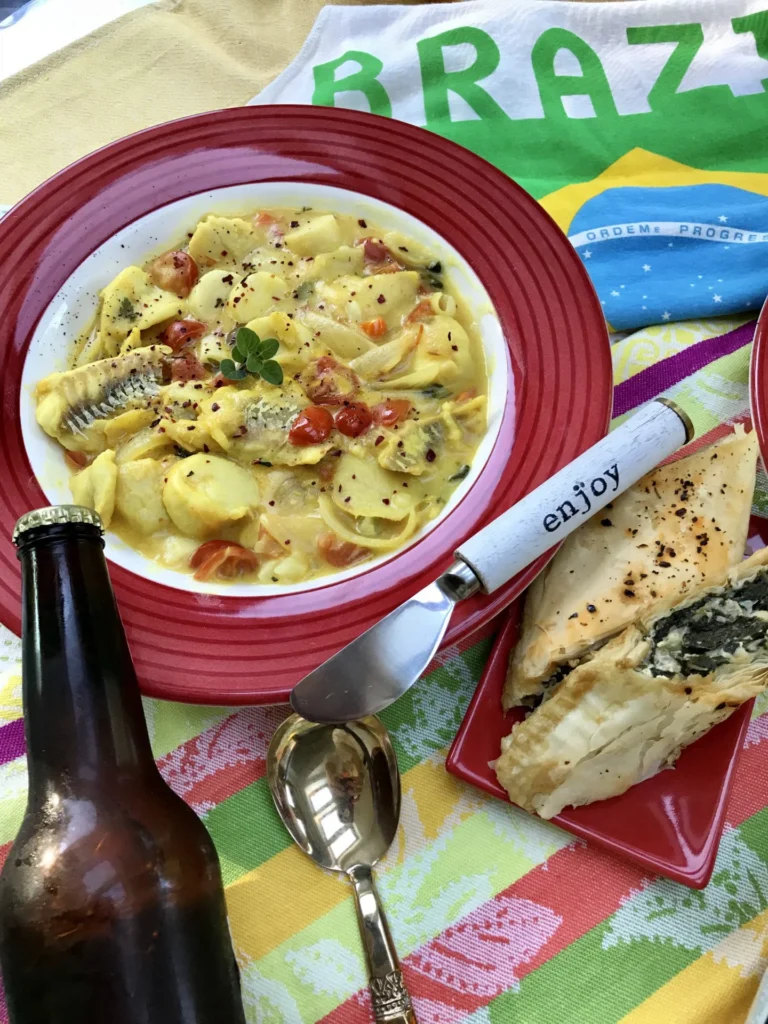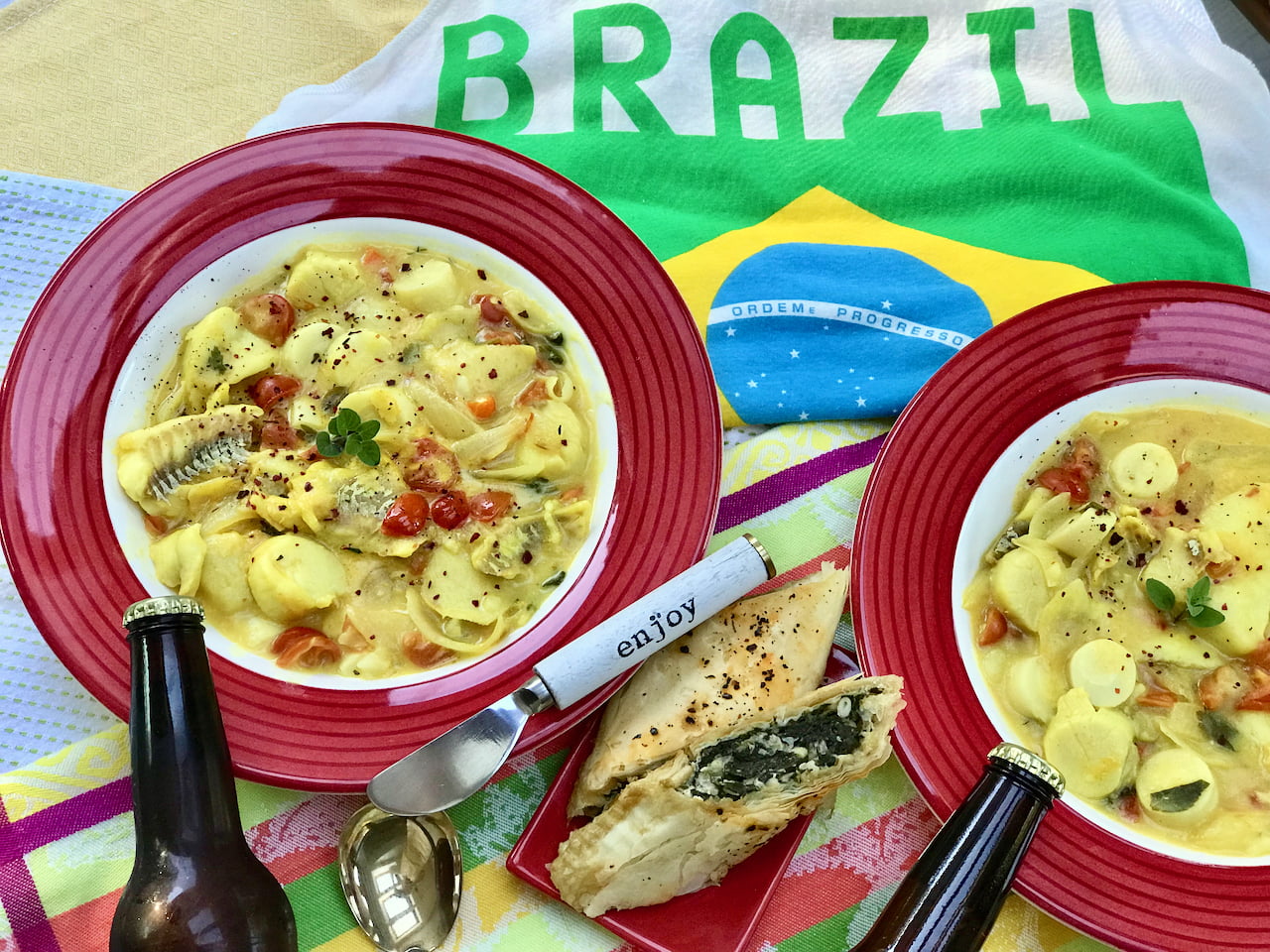Moqueca authentic Brazilian fish stew encompasses the velvety texture of coconut milk, the briny scent of the sea, lime, chilies and a side of Pao de Queijo!
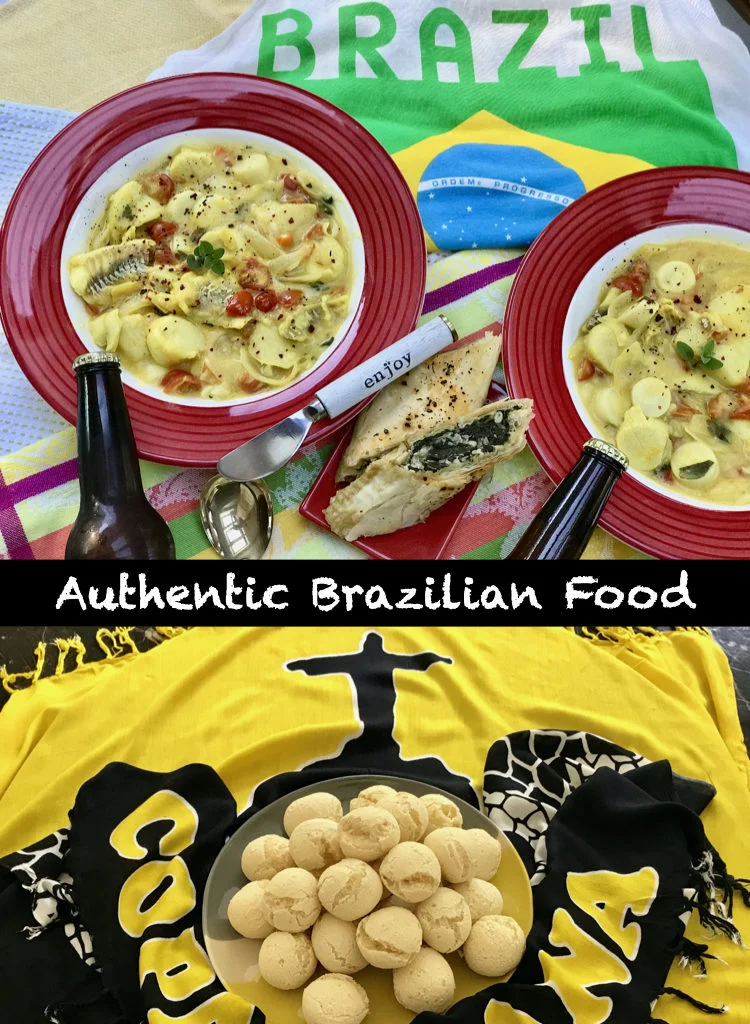
Fish
Nearly every coastal town boasts of its favorite seafood stew, chowder, soup or bouillabaisse.
Having grown up on the Chesapeake Bay, I am proud of our award winning seafood stew recipes, particularly an Oyster Stew or Oyster Chowder made from the oyster Liquor.
These are recipes known to our region in Maryland, and made throughout the winter months, when oysters are in season.
Many of my recipes have been inspired and tweaked by my son Omar Daumit, Executive Chef of Ken’s Creative Kitchen.
Brazilian Fish
For me, no other seafood stew, chowder or soup ever compared to the seafood of Maryland, from its brackish waters, my hometown.
Then I went to live in Brazil for three years and indulged in the abundant sweet, fat shrimp of the coastal areas around Bahia and João Pessoa.
Moqueca was the first Brazilian seafood stew recipe I encountered, known as ‘moqueca de camaroes’ – stew of shrimp.
Once I tasted it, I had to know how to utilize the ingredients of North America and make them taste as though from the Brazilian markets I frequented and adored.
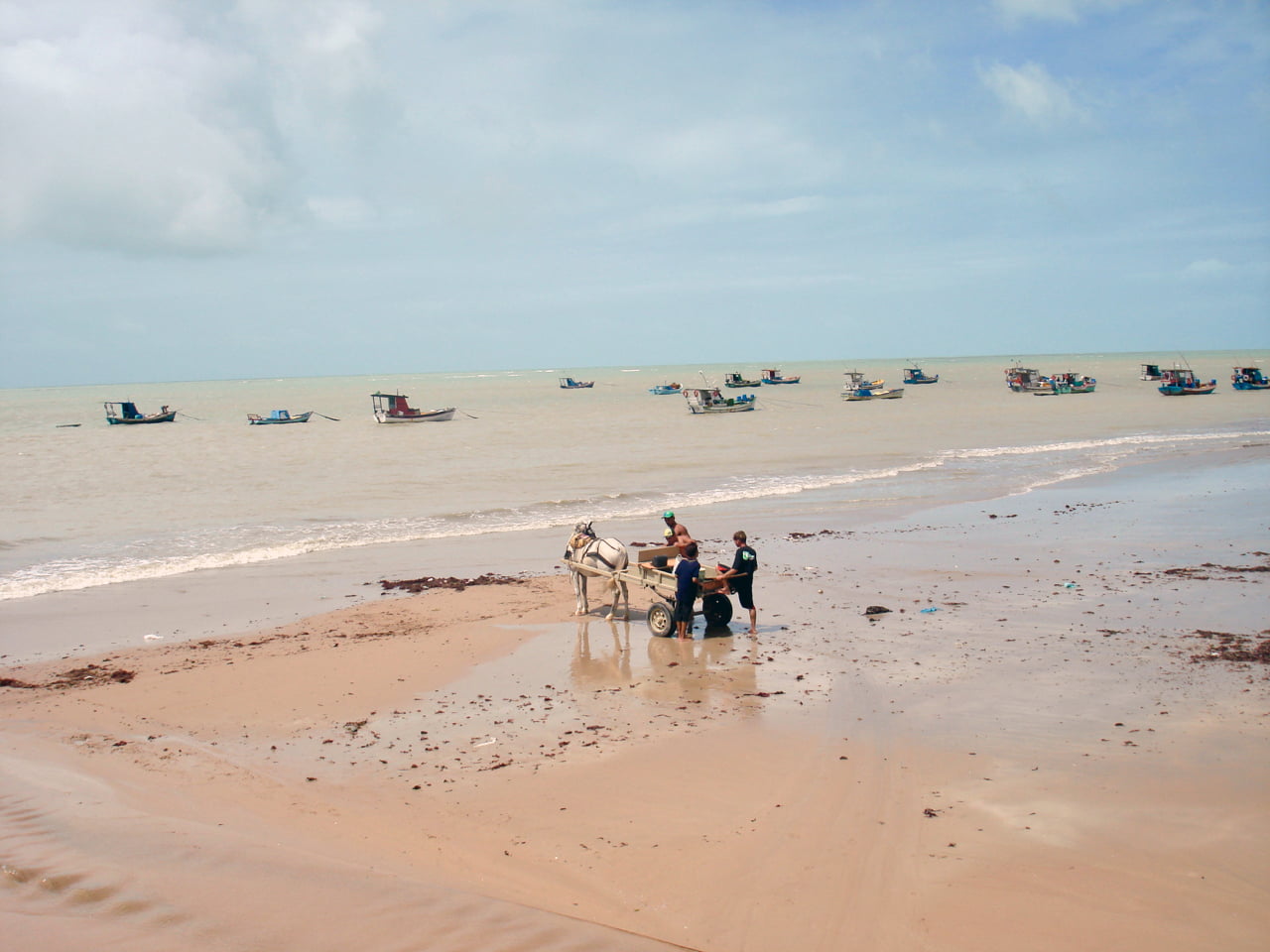
A Brief History Of Moqueca
Like many a recipe, by the same name prepared in various regions throughout Brazil, the recipe adapts to that region.
Since Moqueca is a seafood stew or chowder throughout Brazil, it will help to take a brief look at the history that brought this recipe about.
With the arrival of Africans in Brazil, ingredients known to them became the basis for many of the recipes of Brazil, often known as their national dish.
While Brazil was originally founded on its European roots, Brazil is now 55% Afro-Brazilian, if not more. What does that mean for the cooking of Brazil?
What Goes Into Moqueca?
FLAVOR! Some of the most regional ingredients, such as coconut, chili peppers, dende oil (palm oil), and of course the treasures of the sea, are the basis for Moqueca.
Various regions throughout Brazil will of course tweak the recipe with ingredients from that area, but moqueca is primarily the ingredients you will find in my recipe, because I learned how to cook this dish first hand from friends while living there.
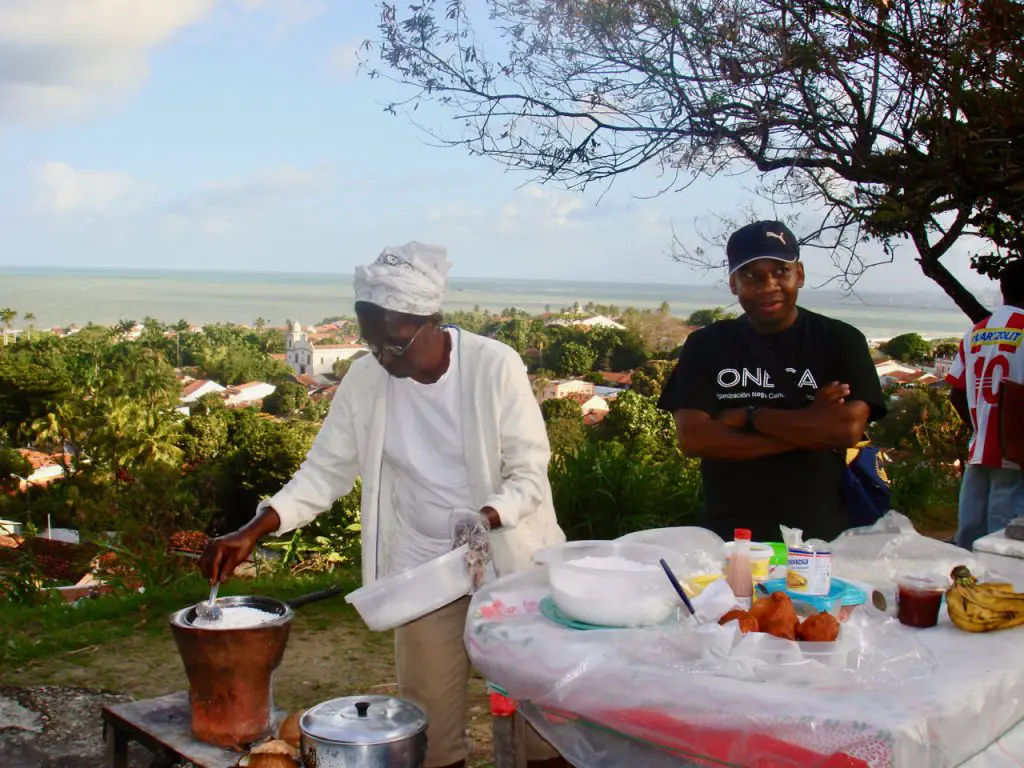
For example, the seafood along the coastal town I visited in João Pessoa and the state of Bahia, is known for its shrimp, therefore, shrimp is the primary seafood in their moqueca.
However, travel north, all the way to the region of Para, this recipe changes to reflect Amazonian fish and many indigenous ingredients of that region, for example Tucupi, a sauce made from manioc/yuca.
I like to think of tucupi as the sauce of Brazil as soy sauce is to Asia.
Brazilian Coastal Towns
Brazil, like every coastal town in America that is proud of their best seafood stew recipes, has many versions of a chowder.
This well known dish, Moqueca, usually uses shrimp in the region of Bahia. However I found other regions of Brazil use other types of seafood in their seafood stew recipe.
The further south you go in Brazil, heading towards the colder waters of Uruguay and Argentina, squid, octopus, sardines and many types of shellfish can be found.
The recipe I want to share with you here, is a culmination of a grandma in Recife, a professional chef in Rio, and a coastal village mom I met in Bahia.
I took the best ingredients, of the versions of seafood stew they shared with me, and created my own adaptation of flavors used in Brazil, yet are also available here in America.
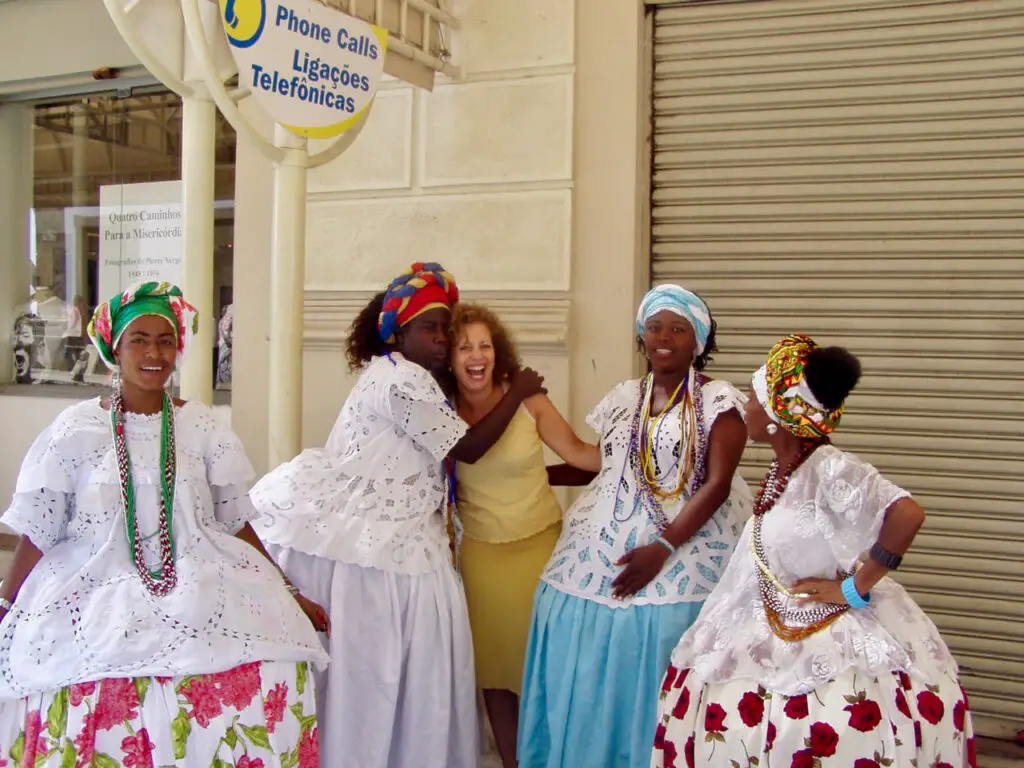
Authentic Brazilian Shrimp Stew
While Brazilian shrimp stew was most common around the coast of Brazil in the region of Bahia, Joao Pessoa and Recife, cod fish was probably the second favored choice of fish used in moqueca.
If you were throwing a big dinner party and wanted to make a huge clay pot of Brazilian fish stew, both shrimp and other fish fillets were used together.
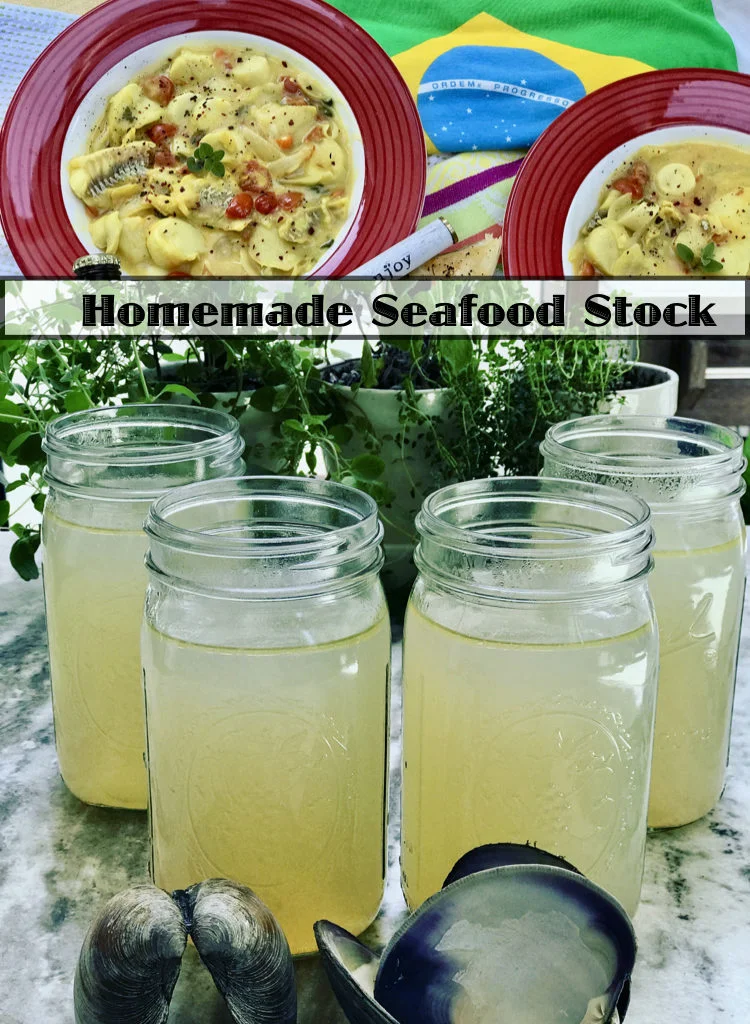
Use The Seafood You Have For This Fish Stew
In short, use whatever seafood you have or prefer in this recipe because the bold flavors in this delicious moqueca will be created with shrimp or fish stock, from boiling the shrimp shells or fish bones.
And please, please don’t substitute the shrimp stock or seafood stock with chicken broth, not if you want an authentic taste, a taste at first bite that will transport you to a coastal fishing village in Brazil!
You’d be better off just using bottled clam juice rather than chicken broth.
You might even envision palm trees swaying in the breeze, the smell of salty air, and the crackling of wood burning on open pits, with an iron cauldron bubbling away on top!
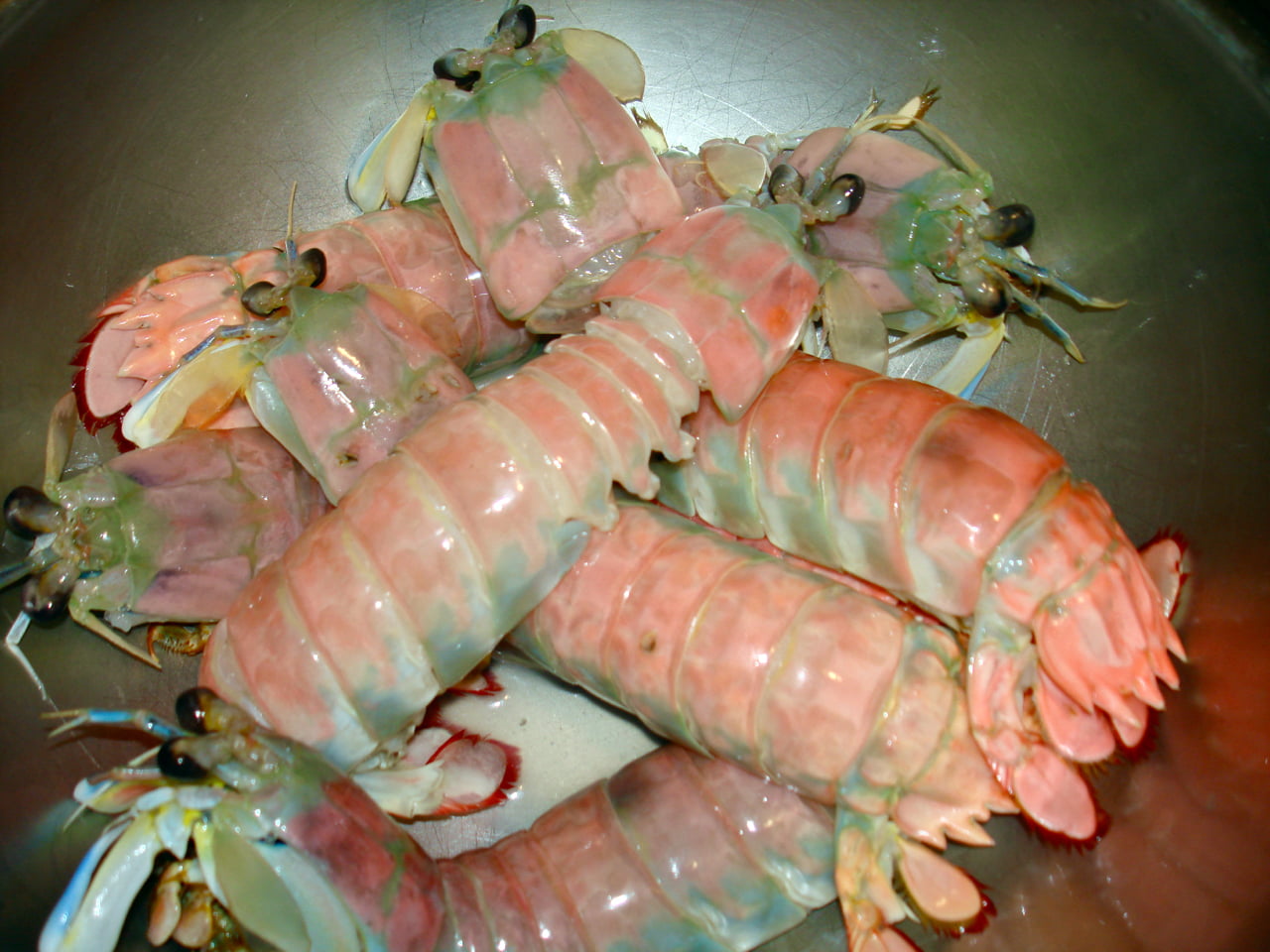
Yuca vs Potato
As is the case throughout the world, when it comes to cooking ingredients, regional products are reflected in regional recipes.
Throughout Brazil, yuca/manioc, is used in every imaginable form.
This hearty root, became the core ingredient in most Afro-Brazilian cooking, all the way back to the beginning of Brazil.
When making moqueca, here in America, I prefer to use yuca vs potatoes, simply because it is traditional to the dish.
Cooking yuca takes a little longer to cook than potatoes, which is why they are often prepared in a pressure cooker, as it is done throughout Brazil.
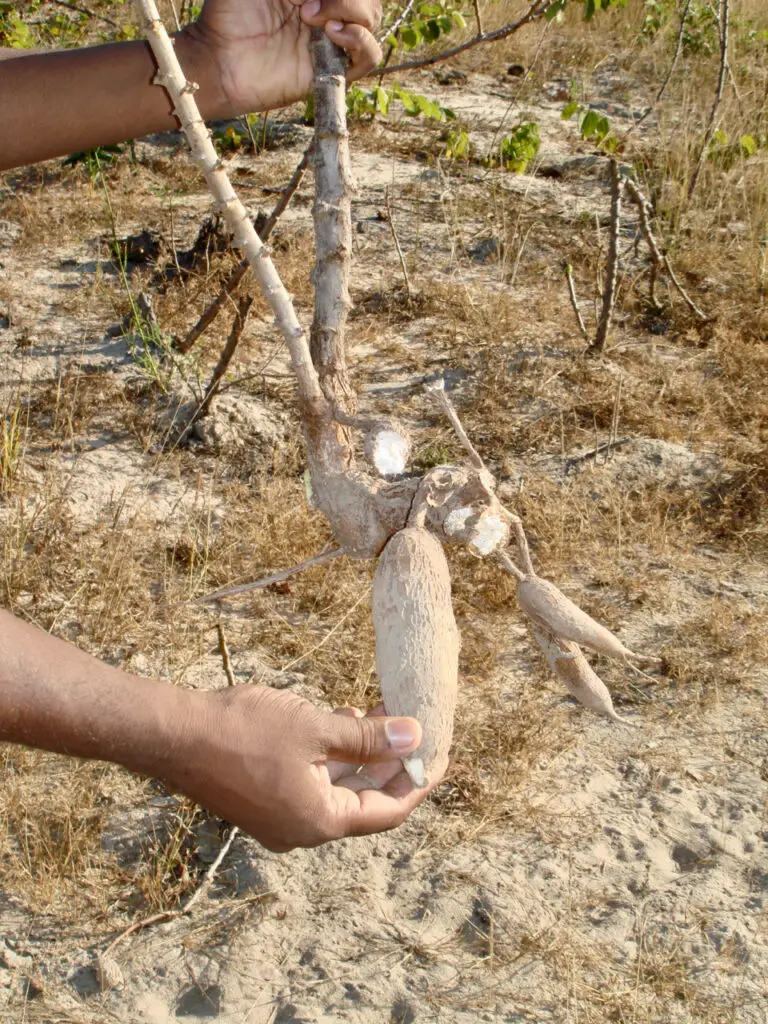
Brazilian Lifestyle
Which brings me to a visual trick I embrace when I want to be put in the mood to make a recipe from another culture.
Films, movies, music, photographs, for me, all help to create a frame of mind or a point of reference when I want to create something amazing in the kitchen.
So, might I suggest to you, before making your very own Seafood Stew, that you take an evening before cooking, and watch the film Woman on Top with Penelope Cruz.
Authentic Brazilian Cooking
I promise that you will dash into the kitchen to make Brazilian Seafood Stew, just as fast as your legs can carry you, or run to the grocery store to gather the ingredients in this recipe!
Better yet, watch the film, make the dish and invite friends over to watch the film with you again while you serve them a hearty bowl of Moqueca – Seafood Stew.
Oh, and while we Americans assume that Brazilians drink only Caipirinha (a strong rum-like drink made with Cachaca, a sugarcane drink), with Moqueca, an iced cold Brazilian beer is what is really served and certainly goes best with it.
However, if you dare to sip on a fabulous cocktail before serving your moqueca, I’d absolutely suggest Brazilian Cachaca Coconut Cocktail!
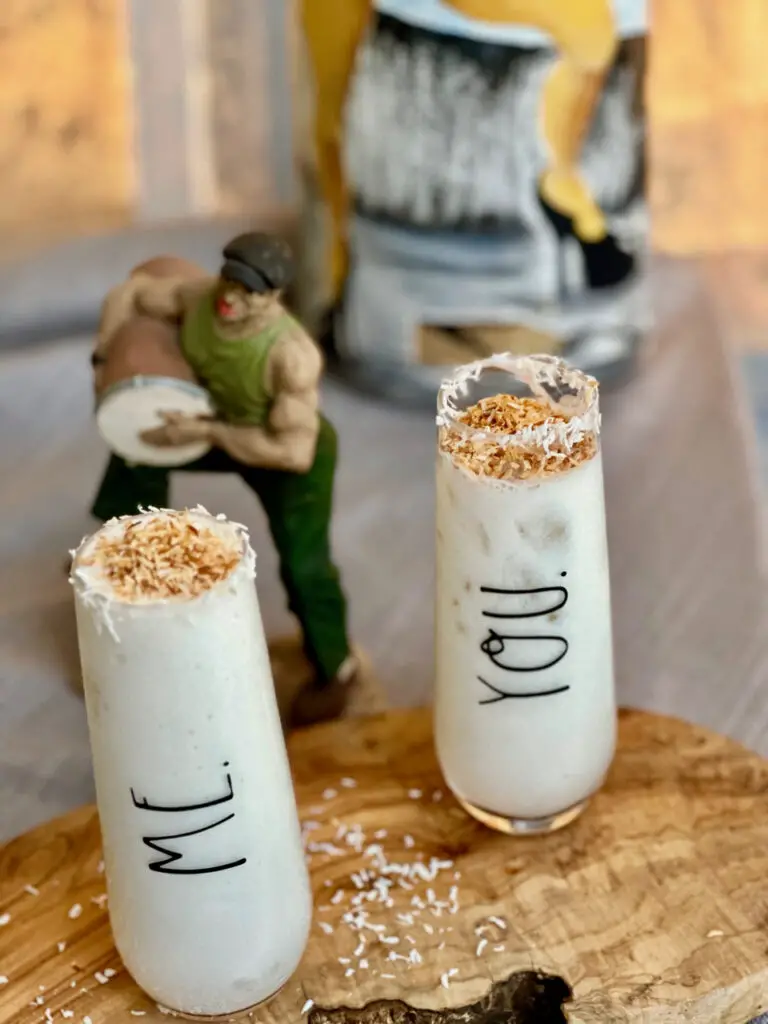
Pão de Queijo – Brazilian Bread
One other Brazilian favorite is often served with this hearty dish: Pao de Queijo a Gluten-free, Tapioca Flour, Cheese Bread.
Aren’t you in luck, because I have that recipe for you here too!
Pao de Queijo takes about 5 minutes to whisk together, scoop into little balls in a muffin tin and can be set aside while you make the seafood stew.
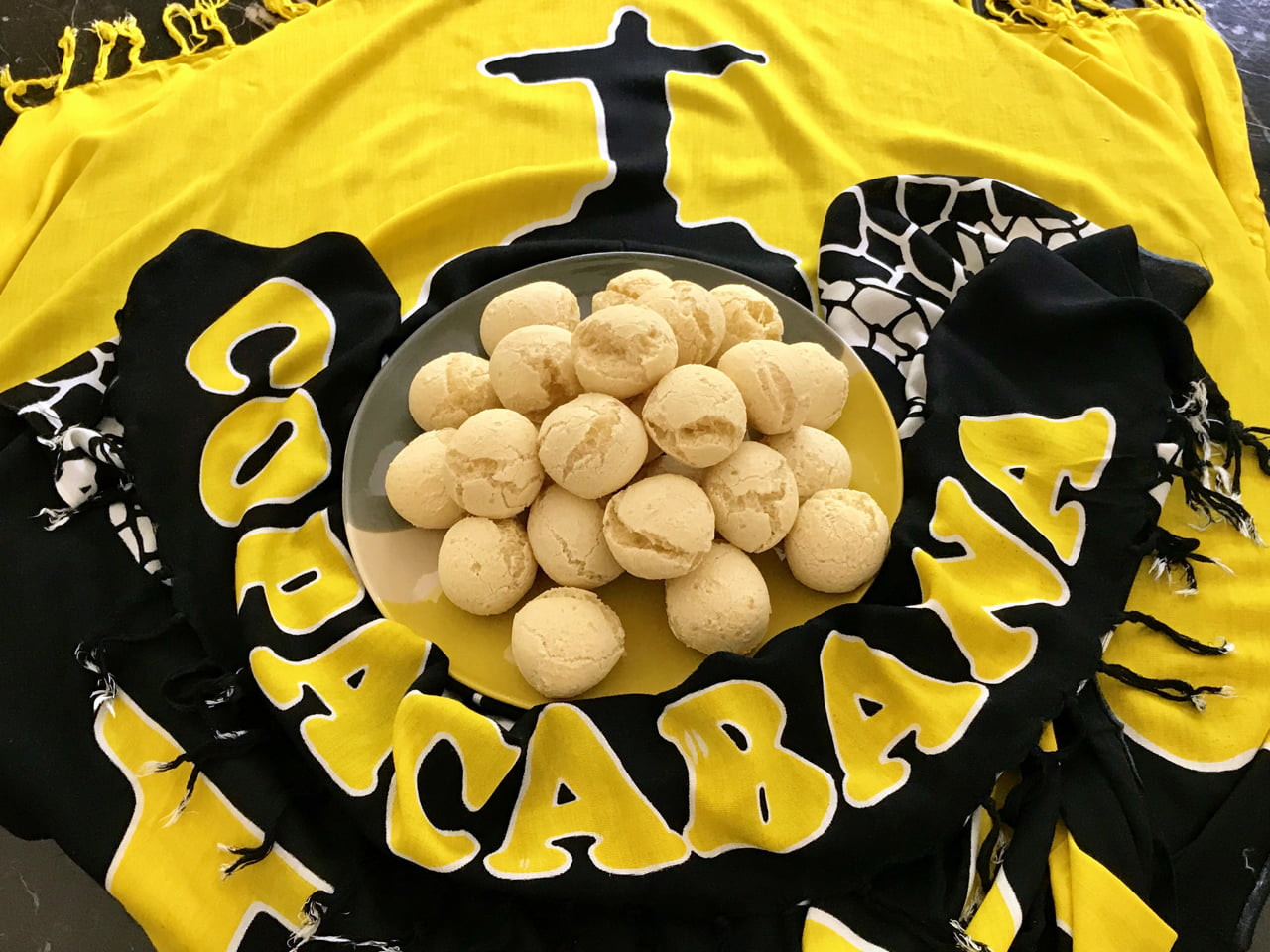
Once the stew is assembled and cooking for the mere 10-15 minutes it needs to simmer, pop the cheese bread into the oven to bake.
Both cook fast and you have an absolutely amazing, very Brazilian meal to serve!
A word about the word Stew… here in America we think of stew as something to serve in the winter.
Don’t let that fool you, Brazil is Hot all year round and these 2 recipes are served all year in Brazil! So, without further ado, put on a little Bossa Nova music and get into the mood.
Moqueca Brazilian Fish Stew – The Great American Recipe
Never did I ever imagine that I would prepare this traditional Brazilian fish stew for American National Television!
If you have a chance to watch, The Great American Recipe Season 1 Episode 6, my Moqueca and Pao de Queijo was a hit!
I did, it was loved and it sure surprised the heck out of the judges to discover I don’t cook inside the box of life, but rather through a vast array of life’s experiences!
Ingredients Needed
- Shrimp, scallops and any fish you can get your hands on.
- Lime juice, with its slighter bitter tang, as apposed to lemon juice works best since lemon is a little sweeter and the coconut milk offers enough sweetness to this chowder.
- Salt and Pepper to taste.
- Garlic, freshly crushed rather than garlic powder which lacks in natural oils and flavor.
- Dende oil, or if you don’t have it, mix a pinch of turmeric powder with coconut oil as a substitute.
- Peppers, both bell peppers of various colors and hot chili peppers.
- Onion, freshly chopped regular onions.
- Tomatoes, fresh tomatoes are preferable though canned plum tomatoes can be used to substitute.
- Cilantro, freshly chopped.
- Paprika either sweet paprika or smoked.
- Seafood stock or clam juice if homemade stock is not available, but please no chicken broth.
- Coconut milk, full fat unsweetened coconut milk.
- Hearts of palm, are an option to add to the fish stew.
- Potatoes or Yucca, precooked.
Equipment Needed
- Stock pot with a lid, preferably stainless steel and not aluminum.
- Cutting board and chopping knife
- Vegetable peeler for the potatoes or yucca.
- Citrus press to extract as much of the lime juice as possible.
- Slotted spoon or ladle.
- Measuring cup and measuring spoons.
- Stovetop or burner
Moqueca Authentic Brazilian Fish Stew
Equipment
- Large stewing pot with a lid
Ingredients
- 2 lbs Shrimp cut into bite size pieces
- 1 lb Black cod or other firm white fish
- 1 lb Scallops
- 2 tbsp Fresh lime juice
- 1 tsp Kosher salt or to taste
- 1 tsp Black pepper
- 3 Garlic cloves crushed
- 2 tbsp Red Palm oil, Dende oil, Coconut oil or Olive oil
- 1 cup Red peppers chopped
- pinch Cayenne pepper or Thai chili
- 1 cup Chopped onion
- 2 Large Tomatoes chopped into small pieces
- 1 tbsp Tomato paste
- 1 bunch Fresh cilantro chopped for garnish
- 2 tsp Smoked Paprika homemade
- 1 cup Seafood stock or Clam juice homemade stock
- 1 cup Full fat coconut milk
- 1 cup Hearts of palm cut into small bites – optional
- 2 cups Yuca or potato parboiled
Instructions
- Place the first 5 ingredients in a large bowl; toss to coat. Marinate in the fridge for 30 minutes or over night.
- Heat the oil in a large clay pot (traditionally earthenware pots), or large Dutch oven over medium heat, taking care not to let it smoke. Add the onions and peppers. Stir while cooking for two minutes. Add the tomatoes and paprika, stir while cooking for 1 minute. Gently fold in the marinated seafood mixture. Add stock and coconut milk, potatoes or yuca and hearts of palm. Bring to the point of a few bubbles, reduce heat, cover and cook for 10-minutes.
- After 10-minutes, check to make sure the seafood is cooked but not over cooked. If the yuca or potatoes were cooked before, they too don’t need to cook for long either. Many layers of flavor are quickly obtained in the cooking of this recipe, simply because each ingredient brings a punch of flavor all their own.
- Cilantro can now be added, once the stove is turned off, or added atop each dish when it is served.
Video
Notes
